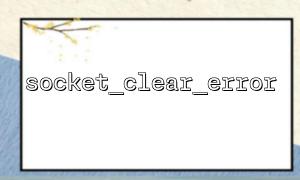In PHP, the socket_connect() function is used to establish a socket connection. When the connection fails, the system will generate the corresponding error message. Proper handling of these errors not only makes the program more robust, but also provides a more user-friendly experience. This article will focus on how to reasonably handle connection errors when using socket_connect() in combination with socket_clear_error() function.
The socket_connect() function attempts to connect to the specified socket address. The basic syntax is as follows:
socket_connect($socket, $address, $port);
$socket : a socket resource created by socket_create() .
$address : The destination address, usually an IP or domain name.
$port : Destination port.
If the connection is successful, the function returns true ; if the connection fails, the function returns false .
When socket_connect() returns false , it is usually necessary to obtain the error code through the socket_last_error() function, and then convert it into readable error information using socket_strerror() .
Sample code:
$socket = socket_create(AF_INET, SOCK_STREAM, SOL_TCP);
if ($socket === false) {
die("Unable to create socket: " . socket_strerror(socket_last_error()));
}
$result = socket_connect($socket, "m66.net", 80);
if ($result === false) {
$errorCode = socket_last_error($socket);
$errorMsg = socket_strerror($errorCode);
echo "Connection failed,Error code:$errorCode,error message:$errorMsg\n";
}
The socket_clear_error() function is used to clear the socket's error status code. Its definition is as follows:
socket_clear_error(resource $socket): void
In some network environments or program flows, the error code may not be cleared after the connection failure, resulting in the impact of subsequent socket operations. At this time, using socket_clear_error() can reset the error status to avoid the old error affecting new operations.
When trying to connect, if you find that the connection fails, in addition to recording an error, you should also call socket_clear_error() in time to clean up the error status to avoid legacy problems. Examples are as follows:
$socket = socket_create(AF_INET, SOCK_STREAM, SOL_TCP);
if ($socket === false) {
die("Unable to create socket: " . socket_strerror(socket_last_error()));
}
$result = socket_connect($socket, "m66.net", 80);
if ($result === false) {
$errorCode = socket_last_error($socket);
$errorMsg = socket_strerror($errorCode);
echo "Connection failed,Error code:$errorCode,error message:$errorMsg\n";
// Clear socket Error status
socket_clear_error($socket);
// You can try again here、Logging or other processing
} else {
echo "Connection successfully!\n";
}
// closure socket Free up resources
socket_close($socket);
Through the above method, after each error is detected, socket_clear_error() is called in time to ensure the stability of subsequent socket operations.
When using socket_connect() , the return value must be detected to determine whether the connection is successful.
When the connection fails, the detailed error information is obtained through socket_last_error() and socket_strerror() .
After the connection fails, call socket_clear_error() to clean up the error status of the socket and avoid affecting subsequent operations.
Combining these functions reasonably can make your socket connection code more robust and adapt to complex network environments.













